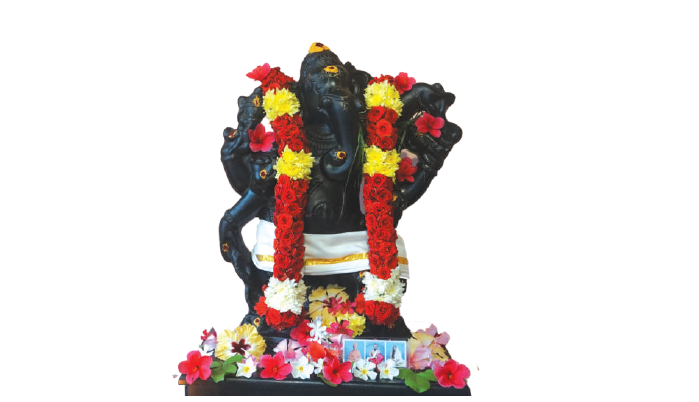गणानां त्वा गणपतिं हवामहे कविं कवीनामुपमश्रवस्तमम् ।
ज्येष्ठराजं ब्रह्मणां ब्रह्मणस्पत आ नश्शृण्वन्नूतिभिः सीद सादनम् ॥ RV 2.23.1
This mantra is from the Rigveda-samhita. It is the first mantra in the 23rd sukta of the 2nd Mandala. There are 19 Mantras in this sukta.

Word meaning
- गणानाम् – of the group of divinities
- त्वा – you
- गणपतिम् – the leader
- हवामहे – we invite
- कविम् — a seer
- कवीनाम् – among the wise
- उपमश्रवस्तमम् – fame comparable to food
- ज्येष्ठराजम् – shining greatly
- ब्रह्मणाम् – of the mantras
- ब्रह्मणस्पते – the lord of the mantras
- आ – completely
- न: – our
- शृण्वन् – hearing
- ऊतिभि: – with protective grace
- सीद – be seated
- सादनम् – the place
Meaning of the Mantra based on Sri Sayana Acharya’s Commentary
O Brahmanaspati, revered guardian and leader of the divinities; foremost among seers, vital as sustenance itself; radiant amidst the eminent; preserver of the sacred utterances; we invoke your presence. Attend to our hymns of adoration, and with and with your protective grace, be seated in our place (of action).
Rishi, Devata, and Chhandas
Rishi: The rishi credited with this mantra is Gritsamada. Gritsamada is ascribed authorship of the second mandala of the Rigveda. The name ‘Gritsamada’ signifies one who possesses intelligence and perpetual happiness.
Devata: This sukta, containing the mentioned mantra, is dedicated to two devatas: Brahmanaspati and Brihaspati. The mantra serves as a prayer specifically to Brahmanaspati, who is later identified as Ganesha or Ganapati. The mantra seeks the presence and blessings of Brahmanaspati.
Chhandas: The 15th and 19th mantras in this sukta are in the Jagati meter, while the remaining mantras, including this one, are in the Trishtup meter. Trishtup consists of four padas, each containing 11 syllables, while Jagati comprises four padas with 12 syllables.
Reflections
Reciting prayers before beginning any task is a tradition rooted in mantras from the Rigveda-samhita. It serves to calm the mind, enhance focus, and align it with the task ahead.
The term “kavi” associated with Brahmanaspati underscores the importance of having clear insight and foresight before undertaking any endeavor.
The epithet Upamashravastama compares Brahmanaspati to food, an essential aspect of sustenance. This is a beautiful contrast to the previous epithet, Kavi. Vision must be supported by practical, grounded action to produce tangible results that foster life.
Furthermore, Brahmanaspati is revered as the lord of mantras, indicating that positive, visionary actions grounded in reality are akin to tapas, or spiritual discipline. Over time, such tapas culminate in profound experiences that may be expressed as mantras, guiding and inspiring those who reflect upon their significance with reverence.
Lastly, Brahmanaspati is revered as the lord of mantras, underscoring the profound connection between tapas, or spiritual discipline, and the insights gained through mantras. Positive, visionary actions grounded in reality constitute tapas, yielding profound experiences over time. When these experiences reach a state of inspired spiritual expression, they transform into mantras.
Therefore, actions should be undertaken as tapas, as they can manifest as guiding mantras, guiding and inspiring those who contemplate their significance with reverence.
Author: Dr M Jayaraman. He is a resident of Chennai, is the Director of Textual Research Division in Yoga, Indic Academy. You can reach to him by: jramanm@gmail.com
